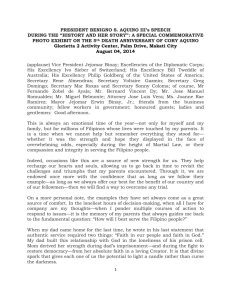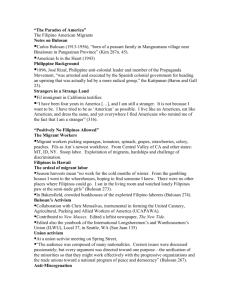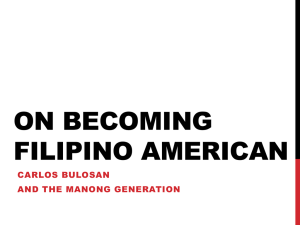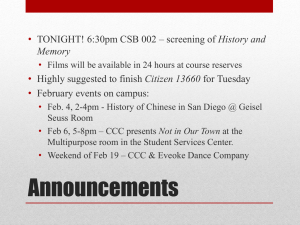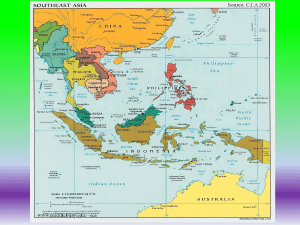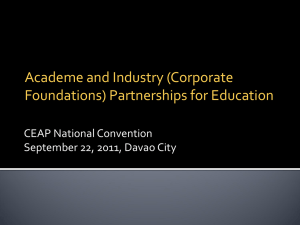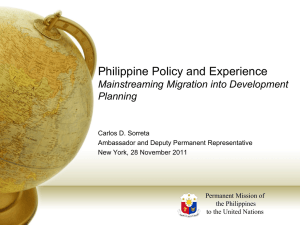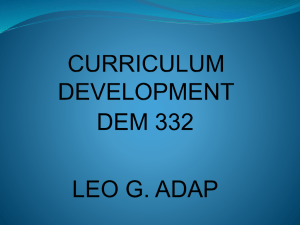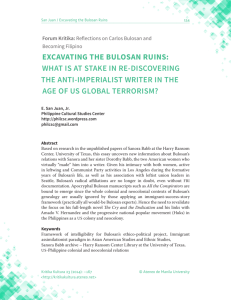filam1_s03.doc
advertisement
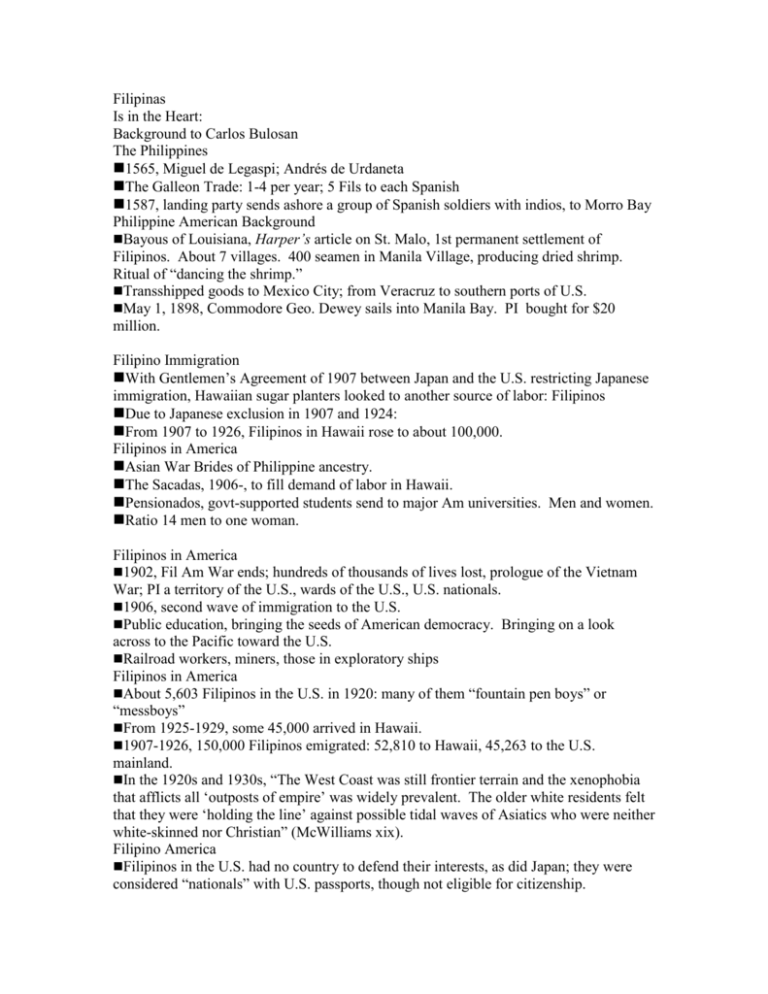
Filipinas Is in the Heart: Background to Carlos Bulosan The Philippines 1565, Miguel de Legaspi; Andrés de Urdaneta The Galleon Trade: 1-4 per year; 5 Fils to each Spanish 1587, landing party sends ashore a group of Spanish soldiers with indios, to Morro Bay Philippine American Background Bayous of Louisiana, Harper’s article on St. Malo, 1st permanent settlement of Filipinos. About 7 villages. 400 seamen in Manila Village, producing dried shrimp. Ritual of “dancing the shrimp.” Transshipped goods to Mexico City; from Veracruz to southern ports of U.S. May 1, 1898, Commodore Geo. Dewey sails into Manila Bay. PI bought for $20 million. Filipino Immigration With Gentlemen’s Agreement of 1907 between Japan and the U.S. restricting Japanese immigration, Hawaiian sugar planters looked to another source of labor: Filipinos Due to Japanese exclusion in 1907 and 1924: From 1907 to 1926, Filipinos in Hawaii rose to about 100,000. Filipinos in America Asian War Brides of Philippine ancestry. The Sacadas, 1906-, to fill demand of labor in Hawaii. Pensionados, govt-supported students send to major Am universities. Men and women. Ratio 14 men to one woman. Filipinos in America 1902, Fil Am War ends; hundreds of thousands of lives lost, prologue of the Vietnam War; PI a territory of the U.S., wards of the U.S., U.S. nationals. 1906, second wave of immigration to the U.S. Public education, bringing the seeds of American democracy. Bringing on a look across to the Pacific toward the U.S. Railroad workers, miners, those in exploratory ships Filipinos in America About 5,603 Filipinos in the U.S. in 1920: many of them “fountain pen boys” or “messboys” From 1925-1929, some 45,000 arrived in Hawaii. 1907-1926, 150,000 Filipinos emigrated: 52,810 to Hawaii, 45,263 to the U.S. mainland. In the 1920s and 1930s, “The West Coast was still frontier terrain and the xenophobia that afflicts all ‘outposts of empire’ was widely prevalent. The older white residents felt that they were ‘holding the line’ against possible tidal waves of Asiatics who were neither white-skinned nor Christian” (McWilliams xix). Filipino America Filipinos in the U.S. had no country to defend their interests, as did Japan; they were considered “nationals” with U.S. passports, though not eligible for citizenship. Caught in “bachelor societies,” young Filipino men often fell into “sharp conflicts with the dominant white majority when they attempted to date white gilrs or gambled or fought among themselves” (McWilliams). Hardships and Oppression Filipinos suffering during the Great Depression. Yet a certain pride in the Fil that not too many in breadlines; reliance on the extended family. Culinary experience: fish heads, fish tails, pig heads, “weeds” that were edible. Taking care of each other though everyone is poor. Nationals who couldn’t own property, couldn’t vote, couldn’t become citizens. Called “little brown monkeys.” Subject to vigilante actions. Miscegenation laws in 16 states. Couldn’t marry a white woman legally until 1948. Living in a ghetto as blatant discrimination. “Positively No Filipinos Allowed”; “No Filipinos served.” Segregation in movie theaters. Notes on Bulosan Carlos Bulosan (1913-1956), “born of a peasant family in Mangusmana village near Binalonan in Pangasinan Province” (Kim 287n. 45). American Is in the Heart (1943) On America Is in the Heart Can be read as bildungsroman or novel of formation: narrates the protagonist’s development form the uncertainty, locality, and impotence of ‘youth’ to the definition, mobility, and potency of ‘maturity’ (45) A Narrative of Assimilation? Narrative of successful self-definition: “(hero leaves poverty and lack of opportunity of the Philippines to become a laborer in the United States; he achieves a state of selfconsciousness that allows him to become a journalist and to author his autobiography)” (45). Bulosan, the writer “[…] Bulosan remains keenly aware of what feudal and colonial practices— sharecropping, land seizure, and exploitation of peasants by church and absentee landlordism—have done to this motherland’ (Kim 44). “for Bulosan, the memories of the Islands never cease to offer inspiration for a continued struggle for a better future”; “Bulosan consciously strives to give voice to thousands of agricultural and menial laborers of Asian America” (44)” Bulosan’s Vision “Bulosan was primarily a fiction writer, and America Is in the Heart is both less and more than a personal history: it is a composite portrait of the Filipino American community, a social document from the point of view of a participant in that experience” (48). “’Epifanio San Juan, Jr., asserts that the book ‘has become an identity-defining primer’ for a million Filipinos in the United States’” (quote in Kim 49). Bulosan the man “Unlike the narrator of America Is in the Heart, Bulosan did not work for extended periods of time in the field and canneries. From the beginning, his health was fragile, and one of his legs was two inches shorter than the other” (47). Became a union organizer. “Bulosan addressed his writing to an American audience in an attempt to win better treatment for his compatriots” (47). Crossover Dreams “The newly arrived Filipino wants to become American, to participate in the beautiful country he has learned about in his homeland” (Kim 49). Counterposed in the novel: “national fiction of a democratic nation-state without sorrow or suffering” / “a nation whose members barely survive owing to exclusion from that nation-state” (Lowe 47). Video: “In No One’s Shadow” “Filipinos in America Directed by Naomi de Castro About Filipino American history from the 1900s to the present Notes from In Nobody’s Shadow (movie) 1st Asians to contribute to American agriculture and economy Territory or protectorate of the US Indentured workers or Sacadas in Hawaii Considered the lowest in rank; sacadas held down as unskilled laborers throughout their lives 1920-34: journeying to the US west coast: Pinoys, Manongs Alaskeros in the salmon cannery industry: 4200 Alaskeros working in the fish houses Working in the fields, 10-25 cents per hour. Fighting racist white unionists. Filipinos in America Pensionados: called “schoolboys” or “Fountain pen boys” Racial discrimination here, about which Filipinos didn’t know Every one Filipina, 20 countrymen Perceived as docile, easily exploited workforce; cut off from their own culture Manongs, “elder brothers,” 10-15 would live in an apartment together to cut on expenses Filipinos in America Pinoy musicians, had to compete with Italians Gambling parlors and taxi dancing halls: buying tickets for a brief contact with women. 1930s, anti-miscegenation laws amended to exclude Filipinos from marriage to white women. Great depression: sentiment that Fils stealing Am jobs Filipino camp dynamited The Watsonville Incident, 1930 Bulosan: “What Impelled Me to Write?” What impelled me to write? The answer is—my grand dream of equality among men and freedom for all. To give literate voice to the voiceless one hundred thousand Filipinos in the United States, Hawaii, and Alaska. Above all and ultimately, to translate the desires and aspirations of the whole Filipino people in the Philippines and abroad in terms relevant to contemporary history” (Quoted in Kim 44). In Reading Notebooks: Please date the “reading days” ~200 words per reading day Comment on the readings Underline book titles and put story and article titles in quote marks Discussion Question for 27 February 2003: What passages illustrate the hardships of life for Allos and his family? Find one or two passages; tell us the page number, read aloud, give a brief comment on significance America Is in the Heart: More passages Dispossession of the land (55) The Spanish Civil War, 1936-39 (56) Uprisings and strikes; Feliz Razon (58-9) History of the Colorum Party (60) Baguio; American tourists (66-8) Miss Mary Strandon, from Iowa; learning, library (69-71) America Is in the Heart: More passages Life in the Tondo and Manila slums (90-2) The cockpit (91) The transatlantic “middle passage”: crossing in steerage (97-8) Pinoys in California cannot pay rent; sold to a recruiting agent for $5 apiece; sent to Alaska to work in the salmon canneries (100) America Is in the Heart: More passages Sad homecoming (70) Dancing with a girl (77) Work on the fishing boat (81-2) “Cheating” on the official test, thwarting the Phil middle class (83-4) Baby lying on the grass (84-5) The family scattered (88) America Is in the Heart: More passages Puzzorobio: foretaste of future struggles; first clash with the Philippine middle class Death of sister Irene (41) José Rizal, Philippine patriot (45-6)) Trying to made ends meet; parrot store (54) Perfumed Nightmare (1978) A movie by Kidlat Tahimik. Mababangong Bangugnot Scenes of village; people trying to get away The provincial life Looking to America as a promised land Philippine Catholicism (San Marco, patron state) Admiring American technology


